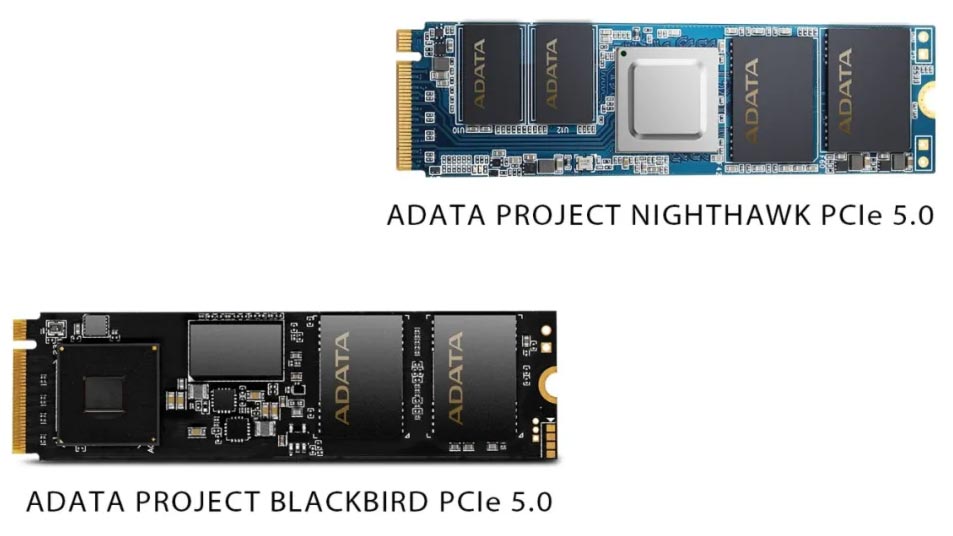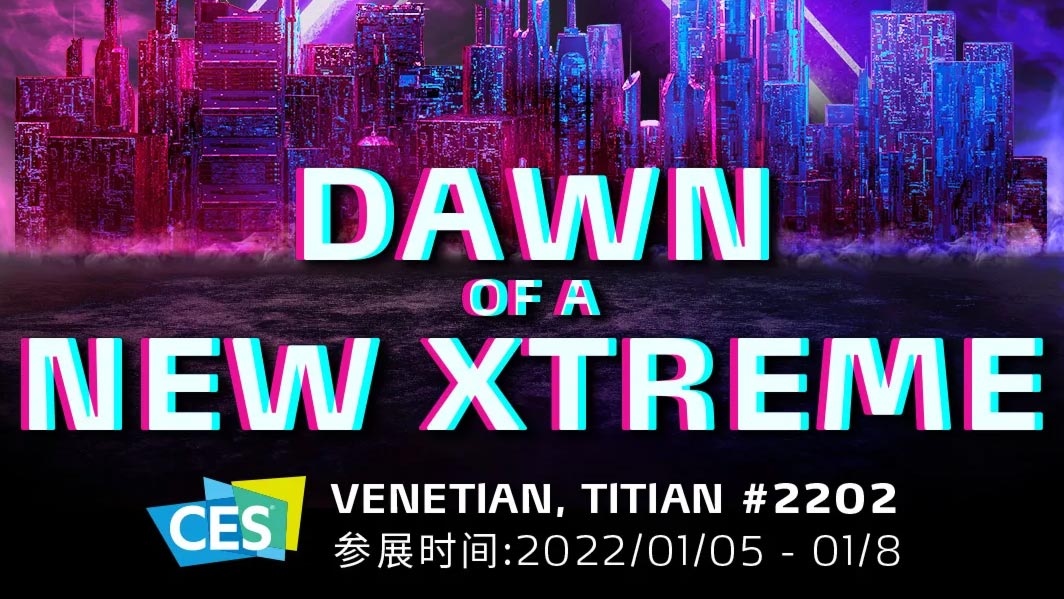Adata Teases First PCIe 5.0 SSDs, up to 14 GBps of Throughput
M.2 2280 prototypes can achieve up to 14 GBps reads, 12 GBps writes.
Adata has released a detailed teaser outlining what to expect from its CES 2022 presentation. The most noteworthy new products come in the form of two PCIe 5.0 SSD designs — the Adata Project Nighthawk PCIe 5.0 and Adata Project Blackbird PCIe 5.0. Adata claims these drives will deliver up to a blistering 14 GBps of sequential throughput, twice the speed of existing PCIe 4.0 SSDs. However, the company hasn't shared any information about random IOPS performance yet.
The firm is priming the public for a wide range of new performance PC DIY components, peripherals and laptops that it will release at CES 2022 under the gaming-centric XPG sub-brand in its Dawn of a New Xtreme presentation on Wednesday, January 5.

Adata's Nighthawk and Blackbird projects
The Adata Project Nighthawk and Blackbird PCIe 5.0 SSDs are admittedly prototypes and are thus framed by Adata's PR department as making "a special appearance" at its booth at The Venetian hotel in Las Vegas. Thankfully, Adata isn't being too cloak and dagger about the star guests and has provided us with some key specs and performance metrics for the next-gen PCIe interface and controller packing M.2. SSD sticks.
Adata's Project Nighthawk PCIe 5.0 is designed using a Silicon Motion SM2508 controller. At this time, we don't know what NAND will be used. However, according to Adata's internal testing, the Nighthawk "is capable of delivering sequential read/write performance of up to 14 / 12 GBps."
The Adata Project Blackbird PCIe 5.0 is differentiated from the Nighthawk by its use of an InnoGrit IG5666 controller. This PCIe 5.0 SSD appears to be balanced differently, less adept at fast sequential writes, and Adata says that it "is capable of delivering read/write performance of 14 / 10 GBps." As mentioned previously, we don't know if the NAND used in these prototypes is a variable affecting performance or not.
In September, Tom's Hardware reported on Kioxia's PCIe 5.0 SSD prototype hitting 14 GBps sequential read transfers, so Adata's figures appear to be in line with expectations. However, Kioxia's test product only achieved 7 GBps writes. At the time, indications were that IOPS figures would be uplifted by 50 to 80% with the move from PCIe 4.0 to 5.0 SSDs.
Both Nighthawk and Blackbird PCIe 5.0 SSD models will be made in capacities up to 8TB, says Adata. We look forward to CES 2022 to pick through more details.
Get Tom's Hardware's best news and in-depth reviews, straight to your inbox.

Other interesting Adata XPG products coming to CES 2022
As well as the above PCIe 5.0 SSDs, Adata will showcase a new Elite SE920 USB4 external SSD with speeds of up to 40 Gbps packed in an actively cooled chassis. Of course its latest DDR5 developments will be in the spotlight too. Adata says its new XPG Lancer RGB DDR5 and Caster RGB DDR5 "deliver next-level performance of up to 6,000 MT/s and 7,000 MT/s, respectively."
Other Adata XPG components you might be interested in, range from AiO coolers and PSUs to full chassis designs. Adata will also have an updated family of XPG peripherals to showcase including a USB Type-C gaming mouse with integrated "XPG vault" SSD.
Last but not least, Adata's CES 2022 booth will feature a range of gaming and ultrabook laptops.

Mark Tyson is a news editor at Tom's Hardware. He enjoys covering the full breadth of PC tech; from business and semiconductor design to products approaching the edge of reason.
-
wifiburger that's nice, there's no x4 pcie5 for any cpuReply
alder lake has x16 pcie5 on the GPU side, but not sure it's worth dropping to x8 just to run 1 nvme at pcie5 and that's mostly on crazy expensive boards
This device could be great for PCIE4 since you'll be at max read/write vs current PCIE4 which may not reach max bandwidth.
But in all honesty, pc games are starting to approach some crazy sizes, like 200gb+ call of duty . Some other games, 40gb,60gb,80gb... etc
My last storage purchase was not nvme or sata ssd.
I went back to hdd, 12TB and does 200Mb/s+ which for games I can't tell the different vs my pcie4 nvme and no clean-up required for managing game installs :-) -
salgado18 Reply
Today, dropping to x8 pcie 5.0 wouldn't hamper any GPU. I don't know the next generation, they seem to be aiming at huge leaps of performance, but today that's not an issue.wifiburger said:that's nice, there's no x4 pcie5 for any cpu
alder lake has x16 pcie5 on the GPU side, but not sure it's worth dropping to x8 just to run 1 nvme at pcie5 and that's mostly on crazy expensive boards
This device could be great for PCIE4 since you'll be at max read/write vs current PCIE4 which may not reach max bandwidth.
But in all honesty, pc games are starting to approach some crazy sizes, like 200gb+ call of duty . Some other games, 40gb,60gb,80gb... etc
My last storage purchase was not nvme or sata ssd.
I went back to hdd, 12TB and does 200Mb/s+ which for games I can't tell the different vs my pcie4 nvme and no clean-up required for managing game installs :)
I agree, SSDs should focus more on capacity than speed at this point. New games will increasingly need fast storage to work properly, but even still the benchmark are consoles, with ~5000 MB/s reads, so pcie 4.0 is sufficient. I bet in some time your HDDs won't be enough for some of those games, since today they rely on disk only at load time, not in real time. -
Im__A__Blimp This is so stupid. Anything past 3500MBPS on PCIe3.0. .... you won't notice it. Your games won't load any faster or run any faster. Even if they did, the difference would be splitting hairs. That's why XBSX didn't use pcie4. They knew this. Focus not on speed, but on consistency, quality, capacity, life longevity. Speed is way overkill and no applicis going to legitimately need anything past PCIe 3 3500Reply -
Alvar "Miles" Udell Innovations such as DirectStorage will also take away some of the requirement of a massively high read speed once they achieve more widespread use.Reply
But yes, some company, especially Samsung, needs to focus on high-capacity M.2 format drives with PCIe 3.0 speed but high capacity. You have the Team Group MP34 4TB for $430, and that's not exactly a slow drive that TomsHardware hasn't tested yet, especially for the price, but all the other 4TB drives are near twice the price.
One could argue 2TB is all you need, with an NAS being much better suited towards bulk storage, but think outside of computers. Phones and tablets, for example, don't need massively fast storage, but they really do need to have 256gb as standard if not 512gb as file sizes increase. Mobile workstations don't need PCIe 4 speed, but they do need large amounts of storage for professional applications. -
hotaru251 pcie 5 is again pointless.Reply
gen 4 was nowhere NEAR capped.
it just inflates cost for stuff that "offers" it. -
Alvar "Miles" Udell Replyhotaru251 said:pcie 5 is again pointless.
gen 4 was nowhere NEAR capped.
it just inflates cost for stuff that "offers" it.
Disagree. Gen 5's lower power consumption and higher bandwidth allow for much more connectivity with fewer necessary connections. You only need an x4 Gen 5 to equate to x8 Gen 4, which mean the next generation video cards from AMD and nVidia won't be bottlenecked. Also in servers they can get much more dense with compute power and not be bandwidth limited.
As far as storage goes, outside of datacenters and high end professional workstations, it is pointless. -
hotaru.hino Reply
Except there's the issue that not everyone is going to be on the latest and greatest. So you'll have something like the RX 5500 where if it reaches a condition that requires a significant amount of PCIe traffic (e.g., VRAM is full and needs to start swapping), having 8 lanes at a reduced speed is going to impact performance. This would make more sense if you wanted to multiplex the lanes, but that adds complexity.Alvar Miles Udell said:Disagree. Gen 5's lower power consumption and higher bandwidth allow for much more connectivity with fewer necessary connections. You only need an x4 Gen 5 to equate to x8 Gen 4, which mean the next generation video cards from AMD and nVidia won't be bottlenecked. Also in servers they can get much more dense with compute power and not be bandwidth limited.
While this doesn't really matter for storage since most consumer use-cases are hardly impacted between SATA 6Gbps and PCIe 3.0 x4 bandwidth, you can't really say the same for video cards.
EDIT: In case I got it backwards that the slot is of a slower version and the device a faster version, it'd still be a problem if the slot was a faster version and the device a slower version, since PCIe negotiates to the slower of the two. While higher end graphics cards haven't seen a significant performance impact at 8 lanes of their "native" PCIe speed, if you wanted to say cut it down to 4 lanes, that's when things may get noticeable. -
Co BIY Comments not showing under the article and showing a Zero comment count even with 7 comments . Comments are only visible by following the link to Comment in the Forum.Reply -
jkhoward Expandable VRAM when? /s (I know it’s been done before but 14 GBps would make a killer buffer for video cards).Reply -
hotaru.hino Reply
It's your system RAM. If the application starts needing more space in VRAM than there's VRAM available, stuff will start swapping from VRAM into system memory (which eats into the application's memory pool)jkhoward said:Expandable VRAM when? /s (I know it’s been done before but 14 GBps would make a killer buffer for video cards).